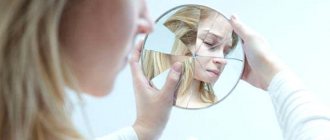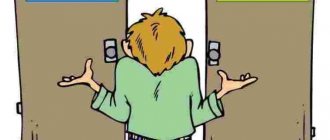Are you ready to stop thinking about your problem and finally move on to real actions that will help you get rid of your problems once and for all? Then perhaps you will be interested in this article .
Types of anxiety should not be confused with types of anxiety. The latter is a situational reaction to a stimulus, disappearing as soon as the impact stops. Anxiety is a feature of the psyche that causes a person to experience anxiety even when there is no reason for the anxiety.
Why is it needed?
It is not for nothing that nature came up with such a personality quality as anxiety. Still, there is an objective danger and threat to life in the world. How to save a person? Only with the help of a built-in danger avoidance mechanism! This mechanism is anxiety.
By the way, it is worth distinguishing between anxiety and fear.
Fear is believed to arise as a reaction to a physical threat. While anxiety should prepare a person to overcome an emotional threat, for psychological impact. Therefore, a moderate level of anxiety is beneficial.
What is anxiety?
When a person constantly experiences anxiety for no apparent reason, and anxious thoughts and panic attacks become his companions in life, this is already harmful to health and develops into pathology and signals mental disorders. This feeling is already turning into an obstacle to normal life. If you do not seek help in time or do not receive it for some reason, the nervous system may not withstand the constant stress. This can lead to disruption of adaptation mechanisms and the development of chronic mental illnesses.
Symptoms of pathological cases can be mental and physical.
Mental signs are:
- the presence of constant causeless fears and worries;
- decreased level of concentration;
- sleep problems;
- an unstable emotional state occurs, frequent irritation, tearfulness, etc.;
- loss of the ability to relax, rest, work and communicate with other people;
- inadequate reactions to the offered help of close associates.
At the physical level, the following symptoms are observed:
- disturbance of the rhythm of breathing and heartbeat;
- pain in the head, in the heart and abdominal cavity;
- sweating;
- increased or loss of appetite;
- unexplained fatigue and loss of strength;
- feeling of trembling, chills for no reason;
- problems with stool;
- presence of a feeling of lack of air;
- lightheadedness;
- spasms and pain in the muscles.
The level of anxiety may vary. In stressful situations it increases and worsens. For a mentally healthy person, it will not be difficult to cope with stress and anxiety. In pathological conditions, emotional negativity remains and can become a constant companion of a person. Panic states are extreme anxiety. Panic attacks come when you don't expect them. After such attacks, people try in every possible way to avoid falling into similar situations. Which naturally affects the quality of life and often leads to a certain isolation from society.
What happens?
I have already said that anxiety can be moderate (that which is only beneficial) and increased. It also happens that it is reduced.
- Moderate anxiety is a kind of internal “bell” that gives a signal as soon as you need to draw attention to something potentially dangerous. This is the norm. The level that does not cause inconvenience, rather helps in life.
- Increased anxiety is the very case when it goes “off scale.” At this level, the body cannot cope with the load and anxiety begins to be expressed in the outside world. External symptoms of increased anxiety are increased sweating and heartbeat, weakness, numbness of the limbs, tics, flatulence, a feeling of a “lump” in the throat, spasms, insomnia. It’s difficult to enjoy life in such a situation; you expect a catch around every corner.
- Reduced anxiety is the other extreme, bordering on indifference and indifference. This level is harmful because it can lead to negligence and ignorance of risk.
In addition to moderate and increased, there are personal and situational anxiety.
- That is, personal anxiety is a feature of the soul that does not depend on the current level of stress. It's always there. It is with this level of anxiety that this or that person lives. Personal anxiety can be high, low, or moderate.
- Situational anxiety occurs when stress levels increase in a relatively short period of time and is associated with new experiences. Fluctuations in situational anxiety are considered normal. Situational anxiety will decrease when stress levels decrease. If stress persists for a long time, then situational anxiety can change the overall level of anxiety.
Anxiety disorder: causes
There are a number of factors that influence the causes of various mental processes:
- Genetics: anxiety, like other character traits, is inherited.
- Biochemical processes occurring in the brain. In anxious people, when the neural network in the cerebral cortex is activated, the limbic system is more activated. It is responsible for autonomic and somatic reactions, as well as emotions and adaptation. The body reacts by releasing hormones, and the feeling of anxiety immediately grows. The brain remembers the sequence of actions, forms neural connections, and when situations or thoughts are repeated, it starts the same process. The brain does not distinguish between real and potential anxiety: thus, maladaptive anxiety is formed.
- Constitutional features: character traits with which a person is born.
- Family. Did the child feel protected, loved and accepted, did secure attachments form so that the person could trust the world: this will influence the development of anxiety in adulthood.
Symptoms can be diagnosed if they are present for at least six months and result in a decrease in the person's functioning. Other symptoms that can lead to similar symptoms are: endocrine thyroid disease, heart disease, caffeine, alcohol, use or withdrawal of illegal drugs.
shutterstock.com
What is anxiety like?
How to separate normal anxiety from pathological?
- Duration. Normal anxiety occurs from time to time, pathological anxiety lasts throughout life or takes a long period of time.
- Temporal focus. It's okay to feel anxious in the present moment, but avoid imagining hypothetical future events that may not even happen but still trigger anxiety.
- Specificity of the threat. You can worry before an exam, an important meeting, in an awkward situation, near a dangerous object. Constant causeless anxiety, social avoidance, uncontrollable anxiety attacks are reasons to consult a specialist.
shutterstock.com
What kind of anxiety should there be?
How do you know if it’s still normal or if it’s “time for treatment”? There is no clear scale. But if you are reading these lines, it means that something is bothering you, and this is connected precisely with the level of anxiety. It makes sense to check (for this, see the test below). It is believed that if, due to increased anxiety, you are experiencing somatic problems, then it is time to change the situation. These problems may be exactly those that I described above - increased heart rate, dizziness, tremors or numbness of the hands, etc. If such symptoms bother you, then something needs to change.
What is an anxiety disorder
Anxiety is a mental disorder characterized by intense feelings of worry and fear. It is normal to experience anxiety, but sometimes the psychological trait develops into constant worry about any reason. In this case, permanent stress becomes part of life.
An anxiety disorder affects about 12% of people, and up to 30% of people experience the disorder at some point in their lives. This psychological feature occurs twice as often in women than in men.
shutterstock.com
How to change your anxiety level?
You can cope with increased levels of anxiety with a psychotherapist (I look forward to seeing you at a consultation!). You can try to change the situation yourself. The easiest way is to change your living conditions and avoid objective disturbing factors.
In addition, self-analysis and working with your thoughts will help. Here the technique of rational-emotional psychotherapy, which you can read about here REBT, can help you
The simplest habits help normalize anxiety levels. Sports, meditation, healthy sleep, pleasant communication. As you can see, in order to stop worrying, you need to not hide in a dark, dark corner, but instead go out into people, look for a place where you will be comfortable.
Anxiety disorder: symptoms
Clinical symptoms of anxiety are quite varied. The most common: stiffness, nervousness, irritation, inability to relax and concentrate, decreased intellectual abilities. From the autonomic nervous system, there are heart rhythm disturbances, changes in blood pressure, shortness of breath, nausea, temperature fluctuations, sweating, migraines, dizziness, muscle spasms. Unlike a disease, a sign of anxiety is polysystemicity, or multiplicity of symptoms.
General symptoms:
- panic, fear and anxiety;
- sleep disturbance;
- inability to remain calm;
- chills, sweating, tingling hands or feet;
- dyspnea;
- cardiopalmus;
- dry mouth;
- nausea;
- muscle tension;
- dizziness.
How do panic attacks manifest?
Separately among anxiety disorders, panic attacks can be distinguished.
A panic attack is a sudden, causeless attack of severe anxiety, accompanied by excruciating sensations: palpitations, a feeling of suffocation, chest pain, dizziness, diarrhea, nausea. This is characterized by a rapid increase in fear and short duration.
People who suffer from panic attacks often perceive the symptoms of a panic attack as a manifestation of a dangerous illness, such as a heart attack or stroke. These anxious thoughts increase the state of panic.
shutterstock.com
Processing the results
Processing the results includes the following steps:
- Determination of indicators of situational and personal anxiety using a key.
- Based on an assessment of the level of anxiety, making recommendations for correcting the subject’s behavior.
- Calculation of the group average indicator of situational anxiety (ST) and personal anxiety (PT) and their comparative analysis depending, for example, on the gender of the subjects.
Key
| ST | Answers | LT | Answers | ||||||
| №№ | 1 | 2 | 3 | 4 | №№ | 1 | 2 | 3 | 4 |
| Situational anxiety | Personality anxiety | ||||||||
| 1 | 4 | 3 | 2 | 1 | 21 | 4 | 3 | 2 | 1 |
| 2 | 4 | 3 | 2 | 1 | 22 | 1 | 2 | 3 | 4 |
| 3 | 1 | 2 | 3 | 4 | 23 | 1 | 2 | 3 | 4 |
| 4 | 1 | 2 | 3 | 4 | 24 | 1 | 2 | 3 | 4 |
| 5 | 4 | 3 | 2 | 1 | 25 | 1 | 2 | 3 | 4 |
| 6 | 1 | 2 | 3 | 4 | 26 | 4 | 3 | 2 | 1 |
| 7 | 1 | 2 | 3 | 4 | 27 | 4 | 3 | 2 | 1 |
| 8 | 4 | 3 | 2 | 1 | 28 | 1 | 2 | 3 | 4 |
| 9 | 1 | 2 | 3 | 4 | 29 | 1 | 2 | 3 | 4 |
| 10 | 4 | 3 | 2 | 1 | 30 | 4 | 3 | 2 | 1 |
| 11 | 4 | 3 | 2 | 1 | 31 | 1 | 2 | 3 | 4 |
| 12 | 1 | 2 | 3 | 4 | 32 | 1 | 2 | 3 | 4 |
| 13 | 1 | 2 | 3 | 4 | 33 | 1 | 2 | 3 | 4 |
| 14 | 1 | 2 | 3 | 4 | 34 | 1 | 2 | 3 | 4 |
| 15 | 4 | 3 | 2 | 1 | 35 | 1 | 2 | 3 | 4 |
| 16 | 4 | 3 | 2 | 1 | 36 | 4 | 3 | 2 | 1 |
| 17 | 1 | 2 | 3 | 4 | 37 | 1 | 2 | 3 | 4 |
| 18 | 1 | 2 | 3 | 4 | 38 | 1 | 2 | 3 | 4 |
| 19 | 4 | 3 | 2 | 1 | 39 | 4 | 3 | 2 | 1 |
| 20 | 4 | 3 | 2 | 1 | 40 | 1 | 2 | 3 | 4 |
Anxiety disorder: how to get rid of it
If you have increased anxiety, you should visit a psychologist or psychotherapist. The specialist will select treatment and, if necessary, refer you to a psychiatrist.
- Short-term therapy: in the process of working with a psychologist, it helps to learn how to monitor an anxious state, prevent such situations, and control your emotions.
- Long-term psychotherapy: in the process, you can find and work out the causes of increased anxiety and change behavior patterns.
- Pharmacology. Medicine may suggest anti-anxiety medications or antidepressants. Taking such drugs is possible only if prescribed by a doctor.
The biggest INJUSTICE and other episodes of the Olympic Games!
Anxiety Disorder: Relaxation Techniques
Diaphragmatic breathing
1. Sit comfortably in a chair, close your eyes, focus on breathing. Breathe for a minute, paying attention to the depth and frequency of your breathing.
2. Breathe with your belly. Place one hand on your stomach and the other on your chest. Make sure that when you inhale and exhale, the hand on your stomach rises and falls, and the hand on your chest remains motionless. Inhale through the nose, exhale through the mouth. The inhalation should be shorter than the exhalation: mentally count to 5 as you inhale, and to 7 as you exhale.
Ground yourself
- Rate your anxiety level: from 0 to 10.
- Take a break: count the number of windows in the house opposite, or how many apartments have lights on.
- Focus on yourself: mentally say what you are wearing, what color your shoes are, what your hands look like, what kind of manicure you want to do next time.
- Inspect the room: what color are the walls and what material are they made of, are there any flaws in the room, what do you like most about it.
shutterstock.com










